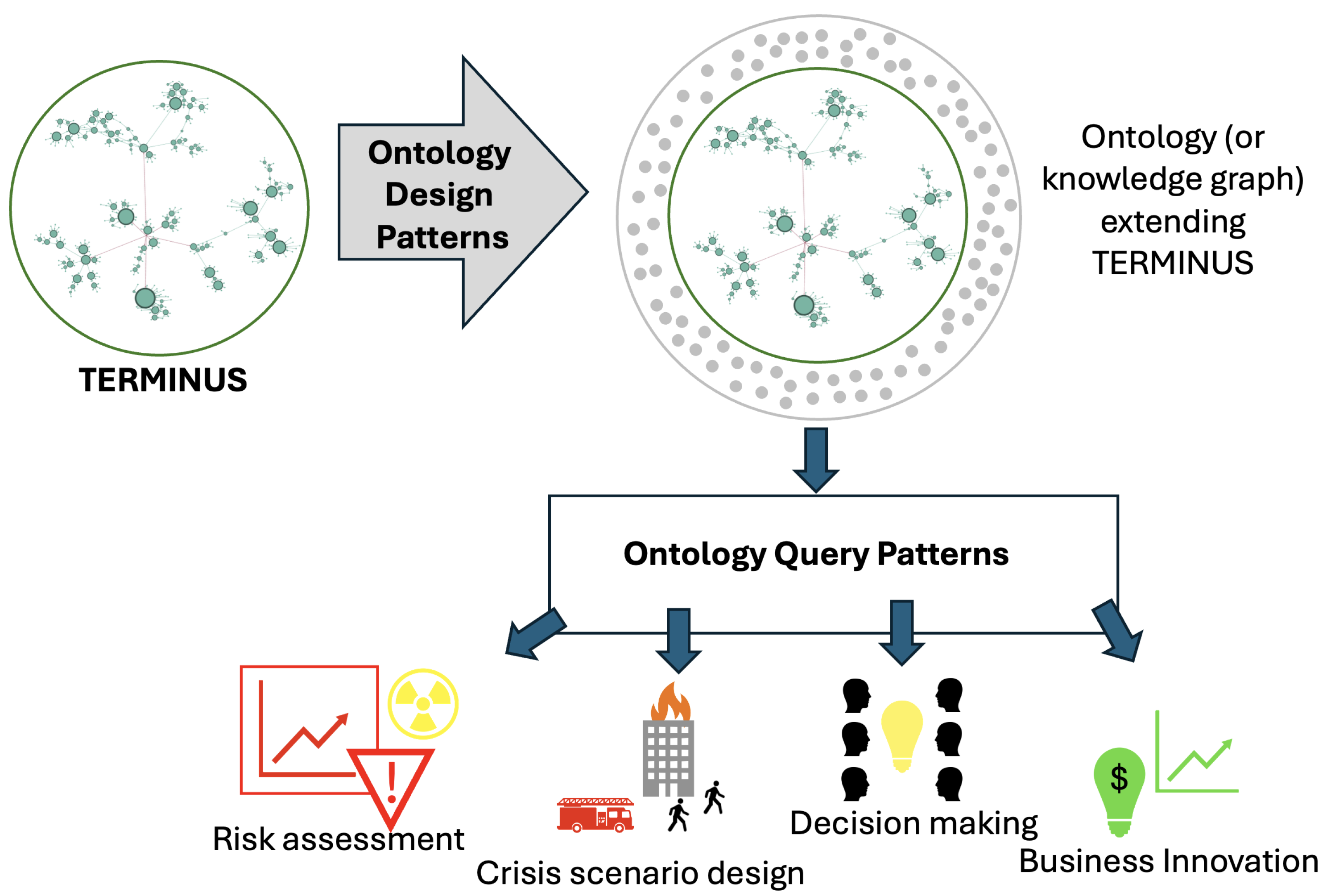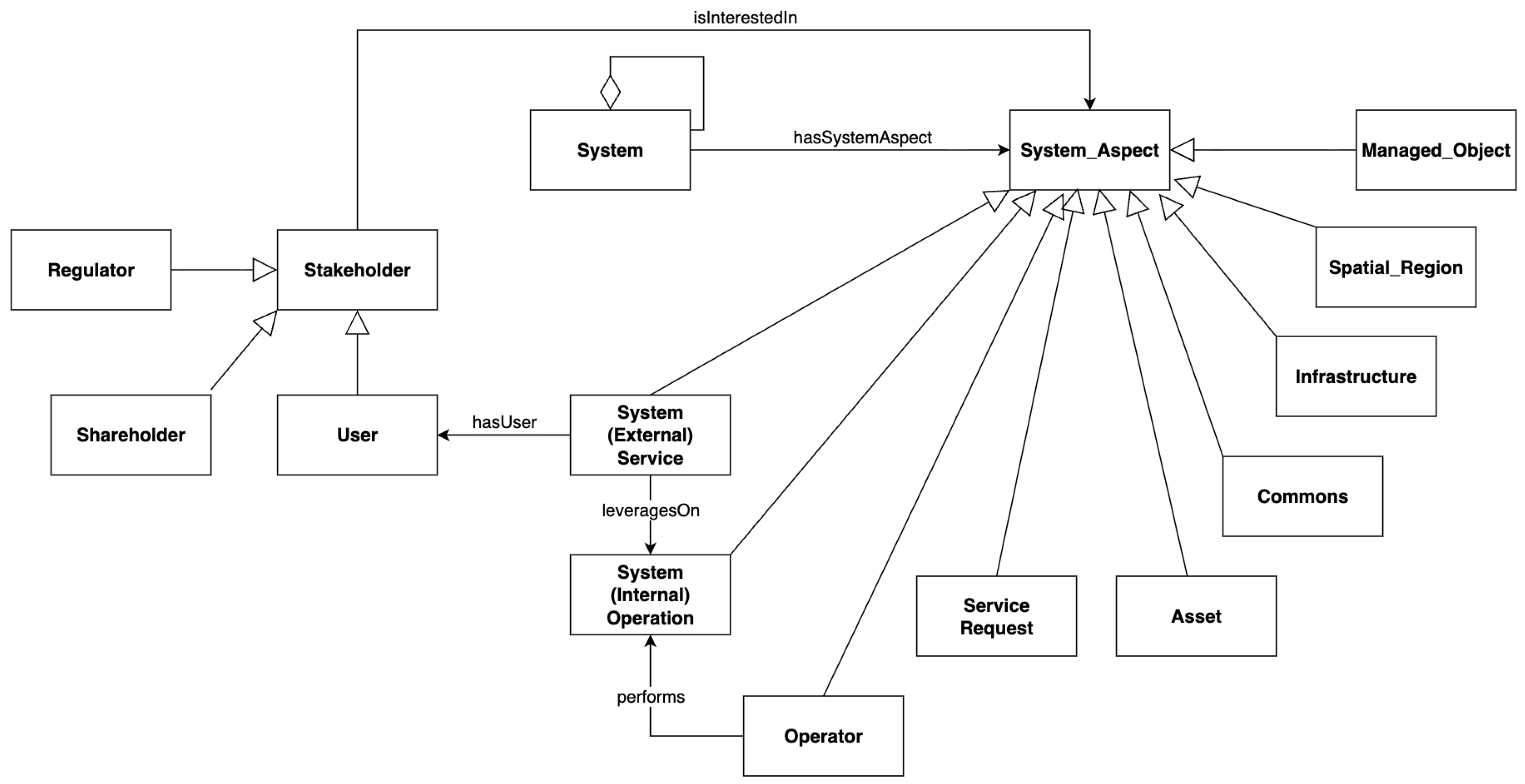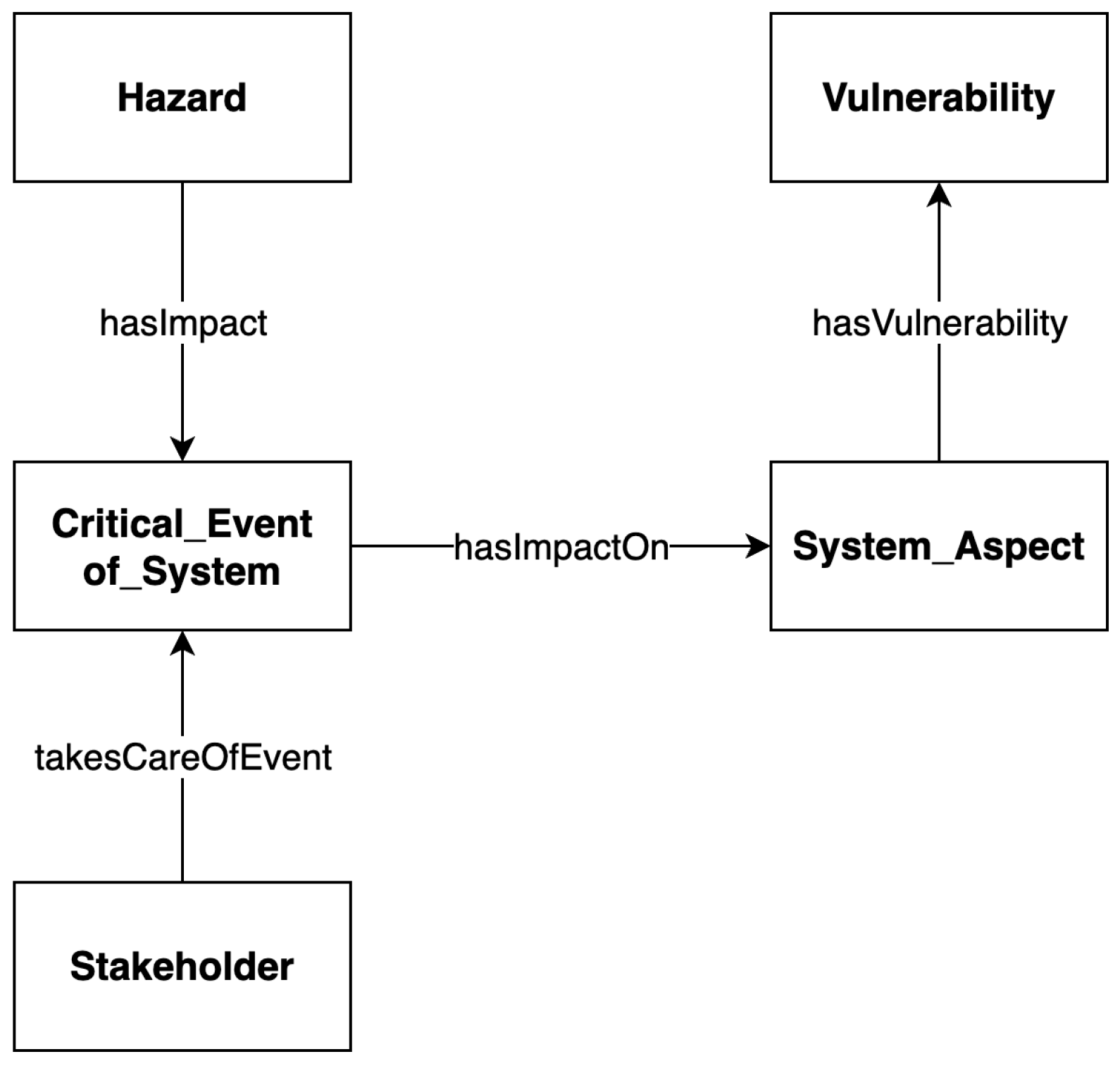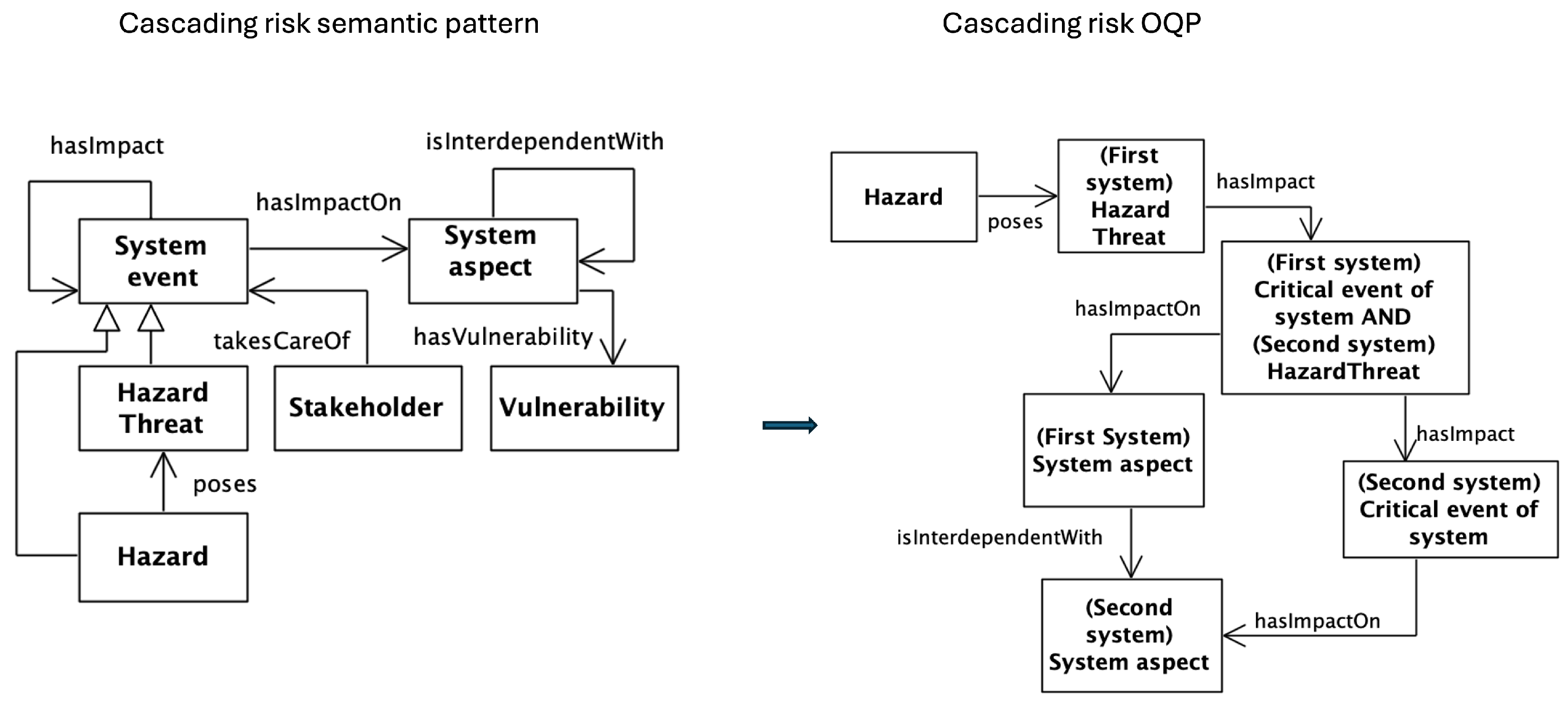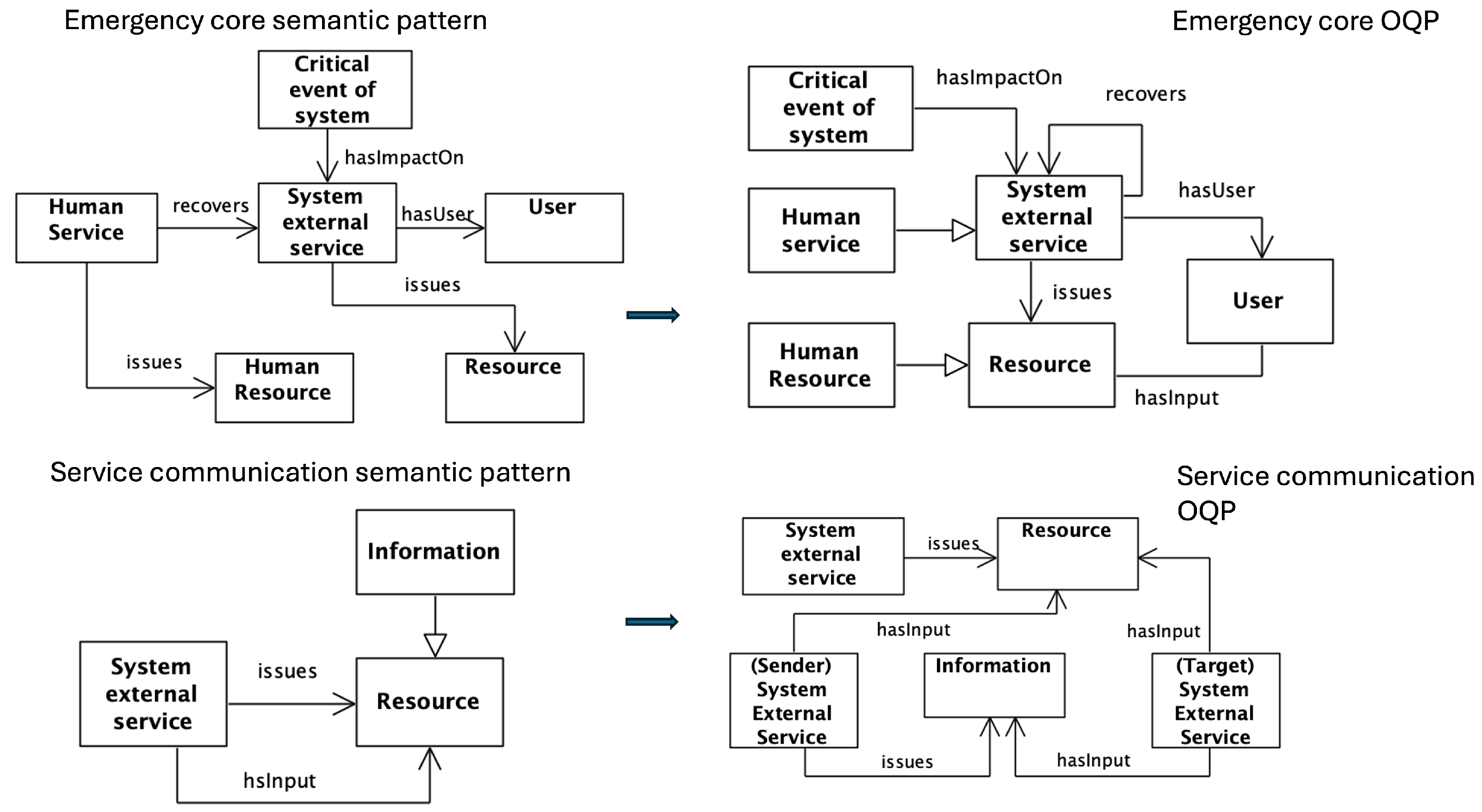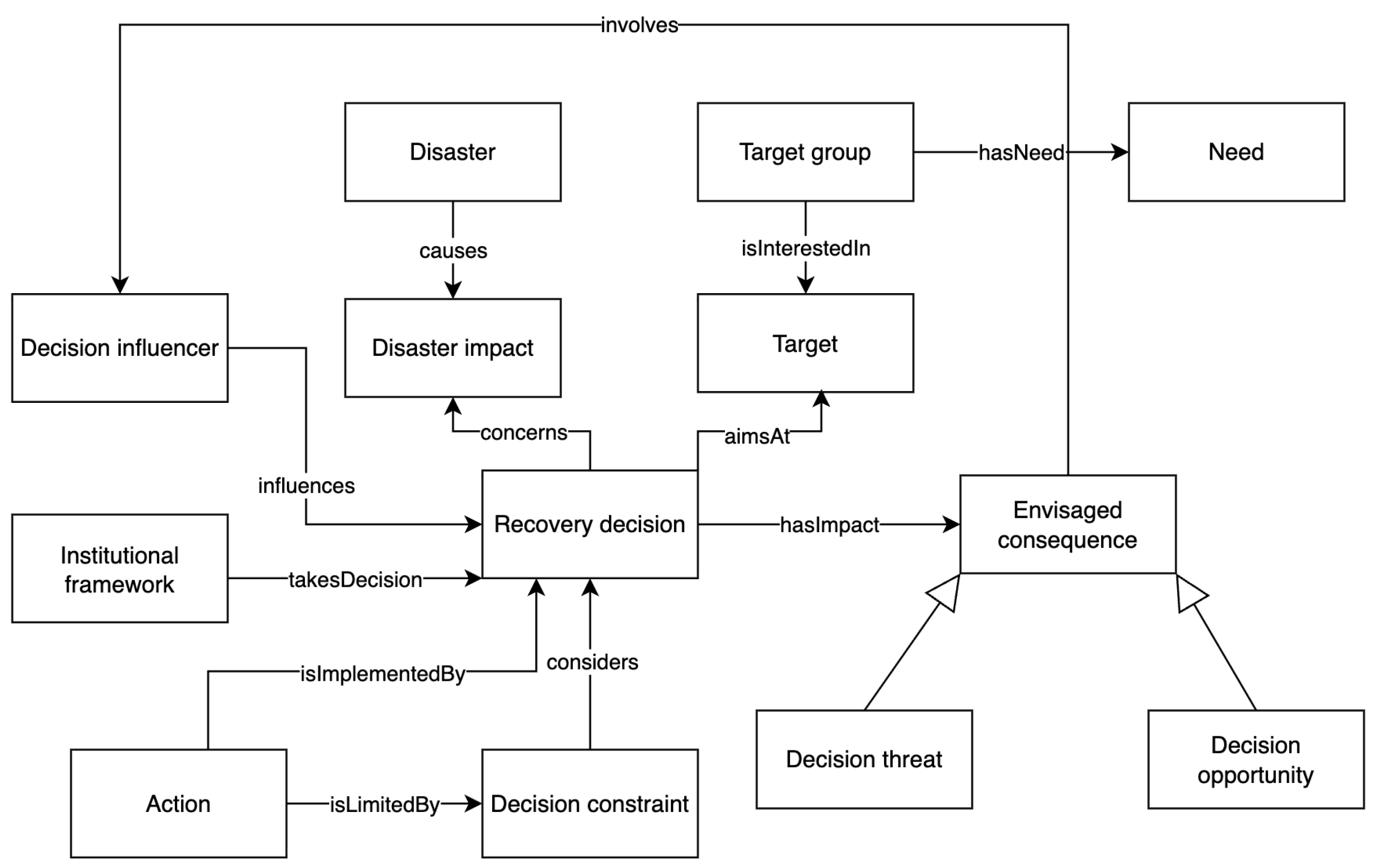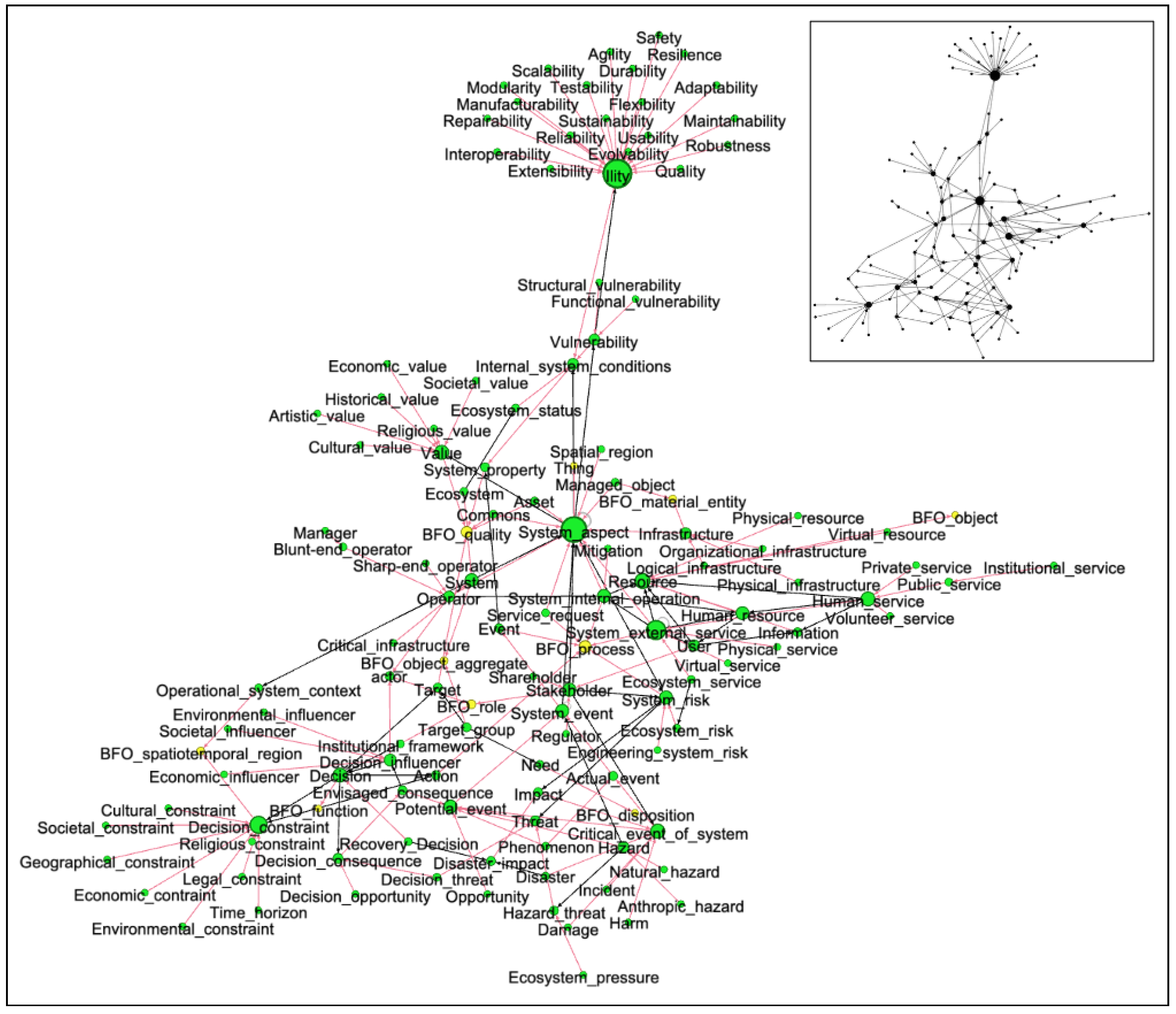3.1. Ontology Engineering
The engineering of the TERMINUS ontology follows established methodologies for ontology construction [
71,
72,
73,
74], adapted to the specific needs of crisis management in smart cities. In line with the software engineering perspective on ontology building, the development process was conceived as an iterative and incremental activity, involving close collaboration between ontology engineers and domain experts. The goal was to ensure that the resulting semantic patterns would be both formally rigorous and directly applicable in real-world scenarios. A lightweight, rapid ontology engineering approach [
74] was adopted to enable frequent validation cycles with stakeholders, reducing the gap between conceptual modeling and operational use. This approach allowed for early deployment of partial models in pilot applications, enabling feedback on terminology, conceptual coverage, and usability before committing to large-scale ontology integration.
The semantic patterns, comprising both ODPs and OQPs, were defined and refined in real operational contexts. Stakeholder engagement was central to this process: workshops, interviews, and co-design sessions were organized with representatives from civil protection agencies, municipal departments, infrastructure operators, and emergency planners. These interactions ensured that the patterns addressed concrete information needs, aligned with existing operational workflows, and supported the decision-making processes [
75,
76,
77] required for effective prevention, preparedness, response, and recovery.
This engineering strategy allowed TERMINUS to evolve as a BFO-aligned, modular, and interoperable ontology framework, grounded in actual practice rather than purely theoretical design. As a result, the ontology not only offers conceptual clarity but also provides immediately deployable knowledge graph structures and query templates tailored to real case studies, such as semantic spatio-temporal risk assessment, cascading risk modeling, and participatory recovery planning.
3.2. Foundational Ontologies
The TERMINUS ontology is grounded in well-established foundational and upper ontologies to ensure semantic rigor, interoperability, and reusability across domains. Foundational ontologies provide high-level, domain-independent categories and relations that serve as a common semantic backbone for integrating heterogeneous domain models.
For formal ontological grounding, TERMINUS adopts BFO as its primary upper-level reference. BFO’s clear separation between continuants (entities that persist through time) and occurrents (entities that unfold over time) enables a consistent alignment of domain concepts such as infrastructures, stakeholders, hazards, and events with a universally recognized top-level framework. This alignment ensures that the ontology’s core patterns, such as the system aspect, risk, and decision-making SPs, are not only internally coherent but also interoperable with other BFO-compliant ontologies in related domains.
TERMINUS can also be considered a foundational ontology in its own right, positioned directly on top of BFO. It extends BFO’s abstract categories with domain-neutral but crisis-management-oriented constructs, such as system aspects, risk propagation structures, and decision-making primitives. These mid-level abstractions bridge the gap between high-level philosophical categories and the domain-specific ontologies or knowledge graphs used in operational applications.
In addition to these upper-level frameworks, TERMINUS integrates the official W3C Time ontology [
69] for representing temporal concepts such as instants, intervals, and durations, which are essential for modeling the temporal dynamics of hazards, cascading events, and recovery actions. Spatial concepts are modeled using the W3C/OGC Basic Geo (WGS84 lat/long) vocabulary [
66] and related spatial ontologies, enabling the precise geolocation of system components, affected areas, and hazard extents. Together, these temporal and spatial vocabularies provide the necessary semantic tools for spatio-temporal reasoning, which is a core requirement in crisis management applications.
By combining these foundational resources, BFO, and W3C’s Time and Space ontologies, TERMINUS establishes a robust semantic infrastructure that supports modular extension, formal reasoning, and seamless integration of knowledge graphs across the full crisis management lifecycle, while itself acting as a domain-oriented foundational layer above BFO.
3.3. TERMINUS Ontology Backbone: The Semantic Patterns
In this section, we describe the set of semantic patterns specifically designed to support the semantic modeling of systems, risks, emergency situations, and decision-making processes in urban and infrastructural contexts. These patterns are categorized into two complementary families: ontology design patterns and ontology query patterns. While both contribute to ensuring semantic consistency and interoperability, they address different aspects of knowledge structuring and exploitation. When used to extend either an ontology or a knowledge graph, a semantic pattern takes the role of an ODP, as it provides a reusable modeling solution that enriches the structure and semantics of the target ontology or knowledge graph. Conversely, when the same semantic pattern is operationalized into reusable query templates aimed at retrieving ontology fragments or knowledge graph instances, it takes the role of an OQP. An OQP remains consistent with the semantics of its underlying semantic pattern. Its topological structure may differ from that of the originating semantic pattern when required by specific application needs, but the intended semantics of the latter must not be violated. Importantly, the same semantic pattern can also assume both roles, ODP and OQP.
For example, the cascading risk semantic pattern structures the representation of interdependencies between infrastructures, allowing the modeling of how a disruption in the energy grid can propagate into failures in transport or healthcare. The same semantic structure can then be expressed as an OQP that retrieves cascading risk scenarios from a knowledge graph, enabling analysts to query not only direct failures but also second- and third-order effects across domains. This dual use illustrates how TERMINUS bridges conceptual modeling and practical knowledge exploitation.
Ontology query patterns, hence, are reusable formal structures for retrieving semantically coherent information from ontology-based knowledge graphs. They are typically expressed as SPARQL query templates grounded in the conceptual structure provided by the corresponding ODPs. OQPs encode recurring information needs, such as identifying all system aspects affected by a specific hazard, or retrieving all decision constraints associated with a recovery plan, thus enabling automated reasoning, scenario generation, and knowledge exploration. In TERMINUS, query patterns are systematically derived from the structural ODPs, ensuring that the way information is queried remains consistent with the way it is modeled.
By combining ontology design patterns and ontology query patterns, the TERMINUS framework supports both the construction of rich semantic models and their operational use in risk assessment, emergency management, and recovery planning. This dual-layered approach allows for the seamless transition from conceptual modeling to data-driven applications, while preserving semantic rigor and interoperability across domains.
Figure 1 illustrates the overall workflow of the TERMINUS ontology and its semantic patterns. On the left, TERMINUS is represented as a conceptual foundation, which is enriched and structured through ODPs. These patterns provide reusable modeling solutions that enable the extension of TERMINUS into more specialized ontologies or knowledge graphs. Once extended, the ontology can be operationalized through OQPs, which act as reusable templates for extracting coherent fragments of knowledge from the ontology and supporting reasoning tasks. The bottom part of the figure highlights four exemplary application domains enabled by OQPs: (i) risk assessment, where patterns support the identification and evaluation of hazards and vulnerabilities; (ii) crisis scenario design, where cascading effects and critical infrastructure interdependencies can be modeled and simulated; (iii) decision-making, where structured knowledge guides coordination and adaptive responses; (iv) business innovation, where semantic structures enable the generation and evolution of new value propositions and service models. Together, ODPs and OQPs ensure semantic consistency while enabling both the conceptual design and operational exploitation of the ontology.
In the following the mentioned semantic patterns are presented in detail. As a roadmap, the patterns below are ordered to mirror their typical use in the crisis management lifecycle: system modeling, followed by risk assessment, cascading effects, emergency scenario design, and, finally, recovery decision-making.
3.3.1. The System Aspect Semantic Pattern
The
system aspect semantic pattern refers to the perspective from which a system is considered by a stakeholder [
23]. It provides a conceptual structure to describe systems not as monolithic entities but through multiple complementary lenses, such as their operations, services, physical infrastructure, managed resources, or the actors interacting with them. This perspective-based modeling is essential for enabling flexible and granular risk or system assessment, especially in complex socio-technical contexts.
Table 2 provides a summary of the core concepts associated with the system aspect semantic pattern. Each concept is briefly described to clarify how it contributes to representing different facets of a system. For instance,
Asset,
Commons, and
Infrastructure capture different types of tangible or intangible system components;
Operator,
Regulator, and
User represent key stakeholder roles involved in managing or interacting with the system; while
System internal operation and
System external service reflect the internal and output functionalities of a system. Together, these elements form a comprehensive vocabulary for analyzing and modeling systems from multiple viewpoints, as required by domain experts, planners, and decision support tools.
The alignment between the
system aspect semantic pattern and BFO provides a foundational semantic structure for interpreting system-related concepts. This alignment ensures that the domain-level constructs used in socio-technical modeling are ontologically grounded in universally accepted upper-level categories.
Table 3 presents the mapping of each core concept from the
system aspect to its corresponding BFO path. These mappings clarify whether a concept should be understood as a continuant (e.g., asset, user), an independent material entity (e.g., infrastructure), a realizable role (e.g., regulator, operator), or an occurrent (e.g., service request, internal operation). This layered interpretation facilitates interoperability, consistency, and reuse of system models in complex domains such as emergency management, smart city planning, and risk assessment.
Figure 2 shows the UML representation of the
system aspect ODP. Examples of systems are socio-technical systems as the water system, the energy system, and the transportation system. Larger systems often encompass and integrate smaller ones, creating interconnected systems that mutually influence each other. The
hasSystemAspect relationship is employed to indicate that a system can be viewed from the various perspectives, known as system aspects: system (external) services, system (internal) operations, operators, service requests, assets, commons, infrastructure, and managed objects. The
isInterestedIn relationship is used to show that stakeholders are interested in specific system aspects.
System service refers to the output of a system provided to stakeholders, such as the distribution of energy to users (as demonstrated by the
hasUser relationship).
System operations, like maintenance, are the internal activities performed within the system, which are essential prerequisites for delivering services.
Operators are the individuals carrying out these system operations (as indicated by the
performs relationship). They can be either blunt-end operators, such as managers, or sharp-end operators, such as lathe turners.
Service requests, such as energy demands, represent users’ requirements for the service.
Assets denote valuable items owned by the system.
Commons refer to cultural and natural resources accessible to all members of society, including natural elements like air, water, and habitable land. Examples of the commons include lakes, water springs, rivers, and glaciers.
Infrastructures model the physical, technological, and organizational structures within a system.
Managed objects represent the entities handled by the system, such as water in the case of a water system or fuel in the case of an oil system.
The following OWL excerpt models a simple knowledge graph based on the system aspect when taking the role of ODP, using artificial data to describe an infrastructure system. In this example, Hospital_A is instantiated as an Infrastructure, which is a specific type of System. It is associated with a corresponding system aspect, Hospital_A_Infrastructure, reflecting the structural viewpoint on the hospital. The hospital is operated by an entity called Operator_A, which is categorized under the Operator class, a role-based perspective on stakeholders. Additionally, the hospital is situated within a spatial region, Rome_City, modeled as an instance of the Spatial_region class. Relationships such as describesAspectOf, operates, and locatedIn are used to semantically connect these entities. This example illustrates how the pattern supports the semantic representation of system components, roles, and contexts in a structured and reusable format.
<rdf:RDF xmlns=‘‘http://www.terminus.org/ontology#’’
xml:base=‘‘http://www.terminus.org/ontology’’
xmlns:rdf=‘‘http://www.w3.org/1999/02/22-rdf-syntax-ns#’’
xmlns:owl=‘‘http://www.w3.org/2002/07/owl#’’
xmlns:rdfs=‘‘http://www.w3.org/2000/01/rdf-schema#’’
xmlns:xsd=‘‘http://www.w3.org/2001/XMLSchema#’’>
<!-- Individual: Hospital_A as a System -->
<owl:NamedIndividual rdf:about=‘‘#Hospital_A’’>
<rdf:type rdf:resource=‘‘#System’’/>
<rdfs:label>Hospital A</rdfs:label>
</owl:NamedIndividual>
<!-- Individual: Hospital_A_Infrastructure as an Infrastructure-->
<owl:NamedIndividual rdf:about=‘‘#Hospital_A_Infrastructure’’>
<rdf:type rdf:resource=‘‘#Infrastructure’’/>
<rdfs:label>Hospital A Infrastructure</rdfs:label>
</owl:NamedIndividual>
<!-- Link the infrastructure system aspect to the infrastructure system -->
<owl:ObjectPropertyAssertion>
<owl:ObjectProperty rdf:about=‘‘#hasSystemAspect’’/>
<owl:NamedIndividual rdf:about=‘‘#Hospital_A_Infrastructure’’/>
<owl:NamedIndividual rdf:about=‘‘#Hospital_A’’/>
</owl:ObjectPropertyAssertion>
<!-- Individual: Operator_A as an Operator -->
<owl:NamedIndividual rdf:about=‘‘#Operator_A’’>
<rdf:type rdf:resource=‘‘#Operator’’/>
<rdfs:label>Operator A</rdfs:label>
</owl:NamedIndividual>
<!-- Individual: Rome_City as a Spatial Region -->
<owl:NamedIndividual rdf:about=‘‘#Rome_City’’>
<rdf:type rdf:resource=‘‘#Spatial_region’’/>
<rdfs:label>Rome City</rdfs:label>
</owl:NamedIndividual>
<!-- Link Hospital_A to its spatial region -->
<owl:ObjectPropertyAssertion>
<owl:ObjectProperty rdf:about=‘‘#locatedIn’’/>
<owl:NamedIndividual rdf:about=‘‘#Hospital_A’’/>
<owl:NamedIndividual rdf:about=‘‘#Rome_City’’/>
</owl:ObjectPropertyAssertion>
</rdf:RDF>
Building on the system aspect semantic pattern, the next subsection introduces the risk semantic pattern, which specializes how hazards, vulnerabilities, and stakeholders interact with specific system aspects to produce critical events.
3.3.2. The Risk Semantic Pattern
The
risk semantic pattern refers to a critical event of system from the perspective of a particular stakeholder [
23]. The purpose of this pattern is to model the risk of a system due to hazards. The key ontological concepts and their definitions involved in this pattern are summarized in
Table 4. These concepts form the foundational elements of a risk modeling framework, capturing how hazards may impact systems, the roles of stakeholders, and the mediating influence of vulnerabilities and system aspects.
Furthermore,
Table 5 illustrates how each concept aligns with BFO foundational concepts.
Critical event of system and
Hazard are modeled as the BFO concept
Occurrent (i.e., process unfolding over time), while
System aspect is directly connected to the notion of the BFO concept
Entity as structured viewpoints on systems.
Stakeholder is captured as the BFO concept
Specifically dependent continuant, particularly as role realized by social actors. Lastly,
Vulnerability is linked to the BFO concept
Quality since it depends on internal system conditions, positioning it within the category of
Specifically dependent continuant as well. This semantic alignment with BFO ensures ontological rigor and interoperability across domains and applications.
Figure 3 shows the UML representation of the
risk semantic pattern. The
hasImpactOn relationship specifies the aspect of the system affected by an event, which could be a physical infrastructure or a system function (e.g., in the case of a cyber-attack or an earthquake). Stakeholders, such as civil protection agencies, are concerned with critical events within the system (as illustrated by the
takesCareOfEvent relationship in the diagram). Typically, the system aspect may have vulnerabilities, such as inadequate maintenance, which could lead to a higher impact (as indicated by the
hasVulnerability relationship).
The following OWL excerpt exemplifies the implementation of the risk when takes the role of ontology design pattern by formally defining specific subclasses aligned with key domain concepts. For instance, Flood is modeled as a subclass of Hazard, while HospitalDisruption specializes the concept of Critical event of system. Other classes such as EmergencyMedicalService, CivilProtectionAgency, and InfrastructureOverload extend System_Aspect, Stakeholder, and Vulnerability, respectively. These subclass declarations instantiate the abstract pattern with concrete examples, illustrating how particular hazards, system aspects, stakeholders, and vulnerabilities can be semantically integrated within a coherent risk representation framework. For the sake of conciseness, we show only how the object property hasImpact has been implemented.
<rdf:RDF xmlns=‘‘http://www.terminus.org/ontology#’’
xml:base=‘‘http://www.terminus.org/ontology’’
xmlns:rdf=‘‘http://www.w3.org/1999/02/22-rdf-syntax-ns#’’
xmlns:owl=‘‘http://www.w3.org/2002/07/owl#’’
xmlns:rdfs=‘‘http://www.w3.org/2000/01/rdf-schema#’’
xmlns:xsd=‘‘http://www.w3.org/2001/XMLSchema#’’>
<!-- Subclass of Hazard -->
<owl:Class rdf:about=‘‘#Flood’’>
<rdfs:subClassOf rdf:resource=‘‘#Hazard’’/>
</owl:Class>
<!-- Subclass of Critical_Event_of_System -->
<owl:Class rdf:about=‘‘#HospitalDisruption’’>
<rdfs:subClassOf rdf:resource=‘‘#Critical_Event_of_System’’/>
</owl:Class>
<!-- Subclass of System_Aspect -->
<owl:Class rdf:about=‘‘#EmergencyMedicalService’’>
<rdfs:subClassOf rdf:resource=‘‘#System_Aspect’’/>
</owl:Class>
<!-- Subclass of Stakeholder -->
<owl:Class rdf:about=‘‘#CivilProtectionAgency’’>
<rdfs:subClassOf rdf:resource=‘‘#Stakeholder’’/>
</owl:Class>
<!-- Subclass of Vulnerability -->
<owl:Class rdf:about=‘‘#InfrastructureOverload’’>
<rdfs:subClassOf rdf:resource=‘‘#Vulnerability’’/>
</owl:Class>
<owl:ObjectProperty rdf:about=‘‘#hasImpact’’/>
…
<!-- Flood hasImpact some HospitalDisruption -->
<owl:Class rdf:about=‘‘#Flood’’>
<rdfs:subClassOf>
<owl:Restriction>
<owl:onProperty rdf:resource=‘‘#hasImpact’’/>
<owl:someValuesFrom rdf:resource=‘‘#HospitalDisruption’’/>
</owl:Restriction>
</rdfs:subClassOf>
</owl:Class>
…
</rdf:RDF>
The following SPARQL query excerpts is a template finalized for retrieving risks from a service perspective, such as touristic services in a city. The query is based on the risk ODP to find its specializations related to specific critical events (excluding generic ones) following plausible hazards for the location at hand, and impacts in relation to functional vulnerabilities and tourist stakeholders.
PREFIX : <http://www.terminus.org/ontology#>
PREFIX rdfs: <http://www.w3.org/2000/01/rdf-schema#>
SELECT DISTINCT ?hazard ?critevent ?sysaspect ?vulnerability ?stakeholder
WHERE {
# selection of classes for service aspect
?sysaspect1 rdfs:subClassOf :System_external_service .
?vulnerability1 rdfs:subClassOf :Functional_vulnerability .
?stakeholder1 rdfs:subClassOf :Tourist~.
# pattern specializations - logical flow from event to a service
?evsys a owl:ObjectProperty;
rdfs:domain ?critevent1 ;
rdfs:range ?sysaspect1 ;
rdfs:subPropertyOf :hasImpactOn .
FILTER ( ! (?critevent1 = :Critical_Event_of_System) )
.....................
# selection of leaf concepts
?sysaspect rdfs:subClassOf :System_external_service .
FILTER NOT EXISTS {?sub_sy1 rdfs:subClassOf ?sysaspect .
?sub_sy2 rdfs:subClassOf ?sysaspect .
FILTER (! (?sub_sy1 = ?sub_sy2)) }
FILTER EXISTS { ?sysaspect rdfs:subClassOf ?sysaspect1 .}
…
# contextual rules, for~example remove hazards
FILTER (
!(?hazard IN (:TropicalStorm, :TropicalDepression)) )
........................
}
Moving from single-system risk to networked settings, we then present the cascading risk semantic pattern, which models how interdependencies propagate critical events across systems.
3.3.3. The Cascading Risk Semantic Pattern
Cascading system risks arise from interdependencies among different systems. The TERMINUS ontology enables the explicit modeling of these interdependencies and offers dedicated ontology query patterns to support the automatic generation of new risk mini-models referring to different but interconnected systems. These OQPs rely on the concepts of the
risk semantic pattern in
Table 4, and on the hierarchy of
System event, which distinguishes between a threat posed by a
Hazard, that may trigger risks (
Hazard threat) and the critical event that may result as consequences on the system (
Critical event of system). These concepts, also defined in
Table 6, provide the semantic foundation for cascading system events due to system interdependencies.
Table 7 shows how these concepts align with BFO. In particular, a
System event is an
Occurrent and abstraction of a
Hazard threat and of a
Critical event of system.
Figure 4 illustrates the semantic pattern that, together with the risk ontology pattern in
Figure 3, provides the concept and the relationships to represent cascading risks. The structural pattern provides the semantic foundation for modeling cascading events in SPARQL queries, as shown in the right figure. The cascading OQP represents how a
Hazard can pose a
Hazard threat affecting a
System aspect of a given system, leading to a
Critical event of system for it. Due to the interdependency with the
System aspect of another system, this critical event translates into a
Hazard threat for the interconnected system.
The following SPARQL query excerpt is a template finalized for retrieving the events of two interdependent systems.
PREFIX : <http://www.terminus.org/ontology#>
PREFIX rdfs: <http://www.w3.org/2000/01/rdf-schema#>
SELECT DISTINCT ?interdepEvent ?sysAspect1 ?sysAspect2 …
WHERE {
# pattern specializations: two interdependent system aspects
?sysAspect1 rdfs:subClassOf :SystemAspect .
?sysAspect2 rdfs:subClassOf :SystemAspect~.
?assys a owl:ObjectProperty;
rdfs:domain ?sysAspect1 ;
rdfs:range ?sysAspect2 ;
rdfs:subPropertyOf :isInterdependentWith .
FILTER ( ! (?sysAspect1 = :SystemAspect) )
....
# selction of events for the two systems
# subclasses of critical event (for system 1)
?critEvent rdfs:subClassOf :Critical_Event_of_System~.
# subclasses of hazard threat (for system 2)
?hazThreat rdfs:subClassOf :HazardThreat_of_System~.
# a subclass that belongs to BOTH categories
?interdepEvent rdfs:subClassOf ?critEvent .
?interdepEvent rdfs:subClassOf ?hazThreat .
...
}
Having characterized how risks arise and propagate, we next shift to crisis management semantic patterns that structure emergency scenarios and their operationalization via query templates (e.g., emergency core and service communication).
3.3.4. The Crisis Management Semantic Patterns
The CEML (Crisis and Emergency Modeling Language) was proposed by De Nicola et al. [
27] as a metamodeling language for designing crisis and emergency management scenarios. The CEML ontology was developed in [
27] to provide formal semantics for the scenario models and to represent domain knowledge in support of creative design. More specifically, the
crisis management semantic patterns derived from the CEML ontology, now part of the TERMINUS ontology, expand on smart city services and on the emergency situations affecting these services as a result of natural or anthropic events. The core entities are described in
Table 8 and were intended to highlight key hooks in any emergency management ontology for linking to taxonomies of concrete elements of a smart city. The abstract entities are the
System external service,
Critical event of system,
User, and
Human service within a smart city. The related entities, such as
Managed object,
Information, and
Human resource allow us to specify the entity properties, and the structure of the situation, through the relationships
issues,
hasUser,
hasHumanResource,
hasImpactOn, and
recovers. These abstract entities allow us to classify the concrete components involved in emergency situations.
Table 9 shows their derivation from the BFO abstract entities.
Various ontological patterns can be defined for the construction of emergency management scenarios. In particular, semantic patterns serve as the foundation for ontology query patterns, which are used to realize SPARQL queries. These query patterns leverage the abstract concepts defined in
Table 8, their semantic relationships, and the class taxonomies provided by the ontology. Two examples of semantic patterns for SPARQL query construction are in
Figure 5. The
emergency core query pattern represents the following generic situation: A
Critical event of system affects a
Service that provides a (critical)
Resource to a
User. Then, a
Human service sends
Human resources to recover the damaged service. The
Service communication pattern represents the following: a
Service issues
Information for another
Service and the exchange leverages a
Resource (e.g., connectivity) provided by a utility
Service (e.g., telecommunication service). Many variants of these patterns can be devised, for example by associating the
Critical event of system entity with service entities to represent additional concurrent or subsequent problems which may arise in the scenario evolution.
The following SPARQL query excerpts shows a template finalized for retrieving communication situations among two different services.
....
# service issuing an information resource
?pro a owl:ObjectProperty ;
rdfs:domain ?sService1 ;
rdfs:range ?infResource1 ;
rdfs:subPropertyOf :issues.
FILTER ( !(?sService1 = :System_external_service) )
# the specific source service
?sourceService rdfs:subClassOf :System_external_service .
FILTER EXISTS {
?sourceService rdfs:subClassOf ?sService1 .
}
# the specific information issued by source service
?infResource rdfs:subClassOf :Information .
FILTER EXISTS {
?infResource rdfs:subClassOf ?infResource1 .
}
# the service target is an information provider
?targetService rdfs:subClassOf :Information_provider .
....
It should be noted that the OQP for crisis management described in De Nicola et al. [
27] is in fact a family of patterns that can be incrementally used to form application-specific SPARQL queries.
Finally, to support post-event recovery choices, the following subsection introduces the decision-making semantic pattern, which encodes concepts, such as needs, constraints, actions, and institutional roles, for structuring recovery decisions.
3.3.5. The Decision Making Semantic Pattern
The decision-making semantic pattern provides a semantic structure to represent the essential components involved in planning and executing recovery decisions in post-disaster contexts. The pattern captures the interplay between actors, impacts, intentions, and constraints that shape how decisions are conceived, justified, and implemented. At its core, there is the concept of Recovery decision, defined as a determination aimed at rebuilding communities, restoring functionality, and enhancing resilience after a disaster.
The
decision-making semantic pattern is composed of a set of interrelated concepts that structure the representation of post-disaster recovery decisions. As summarized in
Table 10, each concept captures a specific aspect of the decision-making process. At the center of the pattern is the concept of
Recovery decision, defined as a determination aimed at rebuilding communities and restoring normal life while preparing for future hazards. Recovery decisions are taken within an
Institutional framework, which refers to the institutional subjects responsible for decision-making.
The pattern also includes the concept of Disaster, described as a sudden calamitous event causing significant harm, and its resulting Disaster impact, which expresses the effects of such an event. These impacts generate one or more Needs, understood as conditions requiring supply or relief, and they affect a Target group, any person, group, or organization that stands to benefit from a decision. Each group has an associated Target, representing the desired outcome to be achieved.
To support implementation, a decision results in one or more Actions, which are specific activities to be performed. However, decision-making is often subject to Decision constraints, defined as legal, technical, or contextual limitations that restrict available options. The process is also shaped by Decision influencers, entities that have a stake in or influence over the decision.
Crucially, each decision involves the anticipation of possible outcomes, referred to as Envisaged consequences. These can take the form of Decision opportunities, potential benefits and Decision threats, factors that might jeopardize success. Together, these concepts form a comprehensive structure for semantically modeling recovery decisions and supporting participatory planning processes.
The decision-making semantic pattern aims to represent the conceptual structure underlying decisions taken in response to disaster events. It includes key concepts such as
Action,
Decision constraint,
Disaster impact,
Need, and
Target group, among others. To ensure ontological clarity and promote interoperability with other domain ontologies, each concept in this pattern is aligned with BFO.
Table 11 presents the full alignment of these concepts within the BFO hierarchy. Specifically, decision-related entities such as
Action,
Disaster, and
Impact are modeled as
Occurrent, reflecting their temporal nature. Roles and functions like
Decision influencer,
Institutional framework, and
Recovery decision are categorized as
Specifically dependent continuant, realized through the activity of social actors or systems. Entities, such as
Target group, are treated as
Material entity, while abstract requirements like
Need and
Target are modeled as
Disposition and
Quality, respectively. This structured alignment enables semantic reasoning, modular reuse of ontology patterns, and consistent integration within BFO-compliant knowledge systems.
Figure 6 illustrates the
decision-making semantic pattern as UML diagram. At the center of the diagram, there is the class
Recovery decision, which acts as the central decision-making entity. This decision is taken by an
Institutional framework, influenced by a
Decision influencer, and operationalized through an
Action, which is itself
limited by a
Decision constraint. The recovery decision
considers one or more
Envisaged consequences, which may take the form of a
Decision opportunity or a
Decision threat. These consequences reflect potential outcomes and risks associated with the decision. The decision is motivated by a
Disaster impact, which is caused by a
Disaster and
concerns a particular
Target, the desired state to be achieved. The
Target is connected to a
Target group that
isInterestedIn it and
hasNeed for recovery, thus linking community priorities with strategic outcomes.
This pattern makes explicit the causal, functional, and institutional relationships that shape recovery decisions, enabling knowledge structuring, reasoning, and participatory deliberation in emergency and resilience planning.
The following OWL excerpt provides an example of how the decision-making semantic pattern, when taking the role of ontology design pattern, can be extended with domain-specific classes to represent a concrete disaster scenario. In this case, a MajorFlood is modeled as a subclass of Disaster, causing a HospitalServiceDisruption, which is a subclass of DisasterImpact. To address the situation, a HospitalRecoveryPlan (a subclass of RecoveryDecision) is taken, constrained by a BudgetLimitation and implemented through an Action such as DeployMobileClinics. The decision is influenced by the MunicipalHealthAuthority and shaped within the EmergencyManagementProtocol institutional framework. The affected population is represented by the FloodAffectedResidents (TargetGroup) with an identified Need for AccessToEmergencyCare. The decision aims at the Target of RestoreEmergencyCareAccess and considers the EnvisagedConsequence of ImprovedHealthOutcomes. The model also accounts for possible DecisionThreats, such as HealthSystemCollapse, and DecisionOpportunities, like BoostCommunityResilience. This extension demonstrates how the pattern can be instantiated to semantically represent complex decision-making dynamics in crisis response scenarios. For the sake of conciseness, we show only how the object property hasNeed has been implemented.
<rdf:RDF xmlns=‘‘http://www.terminus.org/ontology#’’
xml:base=‘‘http://www.terminus.org/ontology’’
xmlns:rdf=‘‘http://www.w3.org/1999/02/22-rdf-syntax-ns#’’
xmlns:owl=‘‘http://www.w3.org/2002/07/owl#’’
xmlns:rdfs=‘‘http://www.w3.org/2000/01/rdf-schema#’’
xmlns:xsd=‘‘http://www.w3.org/2001/XMLSchema#’’>
<!-- Specific disaster subclass -->
<owl:Class rdf:about=‘‘#MajorFlood’’>
<rdfs:subClassOf rdf:resource=‘‘#Disaster’’/>
</owl:Class>
<!-- Specific disaster impact -->
<owl:Class rdf:about=‘‘#HospitalServiceDisruption’’>
<rdfs:subClassOf rdf:resource=‘‘#DisasterImpact’’/>
</owl:Class>
<!-- Specific decision -->
<owl:Class rdf:about=‘‘#HospitalRecoveryPlan’’>
<rdfs:subClassOf rdf:resource=‘‘#RecoveryDecision’’/>
</owl:Class>
<!-- Specific constraint -->
<owl:Class rdf:about=‘‘#BudgetLimitation’’>
<rdfs:subClassOf rdf:resource=‘‘#DecisionConstraint’’/>
</owl:Class>
<!-- Specific action -->
<owl:Class rdf:about=‘‘#DeployMobileClinics’’>
<rdfs:subClassOf rdf:resource=‘‘#Action’’/>
</owl:Class>
<!-- Specific stakeholder -->
<owl:Class rdf:about=‘‘#MunicipalHealthAuthority’’>
<rdfs:subClassOf rdf:resource=‘‘#DecisionInfluencer’’/>
</owl:Class>
<!-- Specific institutional framework -->
<owl:Class rdf:about=‘‘#EmergencyManagementProtocol’’>
<rdfs:subClassOf rdf:resource=‘‘#InstitutionalFramework’’/>
</owl:Class>
<!-- Specific target group -->
<owl:Class rdf:about=‘‘#FloodAffectedResidents’’>
<rdfs:subClassOf rdf:resource=‘‘#TargetGroup’’/>
</owl:Class>
<!-- Specific need -->
<owl:Class rdf:about=‘‘#AccessToEmergencyCare’’>
<rdfs:subClassOf rdf:resource=‘‘#Need’’/>
</owl:Class>
<!-- Specific target -->
<owl:Class rdf:about=‘‘#RestoreEmergencyCareAccess’’>
<rdfs:subClassOf rdf:resource=‘‘#Target’’/>
</owl:Class>
<!-- Specific envisaged consequence -->
<owl:Class rdf:about=‘‘#ImprovedHealthOutcomes’’>
<rdfs:subClassOf rdf:resource=‘‘#EnvisagedConsequence’’/>
</owl:Class>
<!-- Specific threat -->
<owl:Class rdf:about=‘‘#HealthSystemCollapse’’>
<rdfs:subClassOf rdf:resource=‘‘#DecisionThreat’’/>
</owl:Class>
<!-- Specific opportunity -->
<owl:Class rdf:about=‘‘#BoostCommunityResilience’’>
<rdfs:subClassOf rdf:resource=‘‘#DecisionOpportunity’’/>
</owl:Class>
<owl:ObjectProperty rdf:about=‘‘#hasNeed’’/>
…
<!-- FloodAffectedResidents hasNeed some AccessToEmergencyCare -->
<owl:Class rdf:about=‘‘#FloodAffectedResidents’’>
<rdfs:subClassOf>
<owl:Restriction>
<owl:onProperty rdf:resource=‘‘#hasNeed’’/>
<owl:someValuesFrom rdf:resource=‘‘#AccessToEmergencyCare’’/>
</owl:Restriction>
</rdfs:subClassOf>
</owl:Class>
…
</rdf:RDF>
